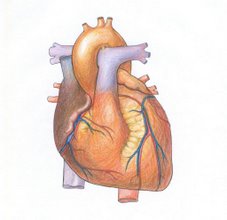
A cardiac arrest, or circulatory arrest, is the abrupt cessation of normal circulation of the blood due to failure of the heart to contract effectively during systole.[1]
"Arrested" blood circulation prevents delivery of oxygen to all parts of the body. Cerebral hypoxia, or lack of oxygen supply to the brain, causes victims to lose consciousness and to stop normal breathing. Brain injury is likely if cardiac arrest is untreated for more than 5 minutes,[2] although new treatments such as induced hypothermia have begun to extend this time.[3][4] To improve survival and neurological recovery immediate response is paramount.[5]
Cardiac arrest is a medical emergency that, in certain groups of patients, is potentially reversible if treated early enough (See Reversible Causes, below). When unexpected cardiac arrest leads to death this is called sudden cardiac death (SCD).[1] The primary first-aid treatment for cardiac arrest is cardiopulmonary resuscitation (commonly known as CPR) to provide circulatory support until availability of definitive medical treatment, which will vary dependant on the rhythm the heart is exhibiting, but often requires Defibrillation.
Causes of Cardiac Arrest
Ventricular fibrillation (VF) constitutes the most common electrical mechanism in cardiac arrest, and is responsible for 65 to 80% of occurrences. Another 20-30% is caused by severe bradyarrhythmias, pulseless electrical activity (PEA) and asystole. Other conditions are associated with impaired circulation due to a state of shock.[1]
Among adults ischemic heart disease is the predominant cause.[6] At autopsy 30% of victims show signs of recent myocardial infarction. Other conditions include structural abnormalities, arrhythmias and cardiomyopathies. Secondary cardiac arrest may be elicited by non-cardiac conditions such as hypoxia from a variety of causes,[7] overwhelming infection (sepsis), pulmonary embolism, arrythmias, cardiac tamponade, shock, pneumothorax, ventricular rupture, as well as other conditions such as electrocution and near-drowning. Non-cardiac conditions constitute the principal cause of cardiac arrest in in-hospital patients.[8]
Coronary heart disease (CHD) -also known as coronary artery disease, or (CAD)- is the predominant disease process associated with sudden cardiac death in the United States and elsewhere in the developed world. The incidence of CHD in individuals who suffer sudden cardiac death is between 64 and 90%.
In children, cardiac arrest is typically caused by hypoxia from other causes such as near-drowning. With prompt treatment survival rates are high.
Treatable causes
The most important treatable cause of cardiac arrest is ventricular fibrillation. The only 
For other causes of cardiac arrest, the best treatment is prevention. Aggressive therapy innitiated in the peri-arrest period may prevent cardiac arrest and subsequent death. Reversible causes of asystole and pulseless electrical activity include the "Hs and Ts.
